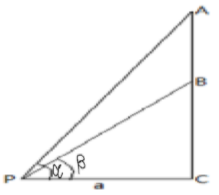
The angle of elevation of the top and bottom of a flag staff fixed at the top of a tower at a point distant $a$ ft. from the foot of the tower are $\alpha $ and $\beta $. The height of the tower is ________
A. $a\left( {\tan \beta - \tan \alpha } \right)$
B. $a\left( {\tan \beta + \tan \alpha } \right)$
C. $a\left( {\cot \beta - \tan \alpha } \right)$
D. None of these
Answer
122.7k+ views
Hint: Draw the diagram of the given problem statement for a better understanding of the situation. Use the trigonometric ratios, that are $\sin \theta = \dfrac{{{\text{Opposite}}}}{{{\text{Hypotenuse}}}}$ and $\tan \theta = \dfrac{{{\text{Perpendicular}}}}{{{\text{Base}}}}$ in the physical triangle formed to find the height of the tower.
Complete step by step answer:
Let us assume the point at a foot distant from the tower be $P$.
We can draw the figure for the given scenario, where the flagstaff is fixed on the top of the tower, which is a foot distant from $P$.
The point $P$ lies in the plane of the bottom of the tower. The angle of elevation from point P to the top of the flag staff is $\alpha $ and angle of elevation from the point $P$ to the bottom of the flag staff is $\beta $.

Here $BC$ represents the height of the tower and $AB$ represents the height of the flag staff.
From the figure, in the triangle $PBC$
$\tan \beta = \dfrac{{BC}}{{PC}}$
Substituting $a$ for \[PC\] we get
$\tan \beta = \dfrac{{BC}}{a}$
On simplifying, we get
$a\tan \beta = BC$
Here $BC$ represents the height of the tower, therefore, the height of the tower is $a\tan \beta $.
Thus option D i.e. none of these is the correct answer.
Note: The diagram should be drawn correctly according to the given conditions correctly. The angle of elevation of a higher point is more than that for a lower point in the same vertical line. In a right angled triangle, the $\tan \theta $ is the equal to $\dfrac{{{\text{Perpendicular}}}}{{{\text{Base}}}}$, where perpendicular is the side opposite to the angle $\theta $, and $\sin \theta $ is the equal to $\dfrac{{{\text{Perpendicular}}}}{{{\text{Hypotenuse}}}}$, where perpendicular is the side opposite to the angle $\theta $.
Complete step by step answer:
Let us assume the point at a foot distant from the tower be $P$.
We can draw the figure for the given scenario, where the flagstaff is fixed on the top of the tower, which is a foot distant from $P$.
The point $P$ lies in the plane of the bottom of the tower. The angle of elevation from point P to the top of the flag staff is $\alpha $ and angle of elevation from the point $P$ to the bottom of the flag staff is $\beta $.

Here $BC$ represents the height of the tower and $AB$ represents the height of the flag staff.
From the figure, in the triangle $PBC$
$\tan \beta = \dfrac{{BC}}{{PC}}$
Substituting $a$ for \[PC\] we get
$\tan \beta = \dfrac{{BC}}{a}$
On simplifying, we get
$a\tan \beta = BC$
Here $BC$ represents the height of the tower, therefore, the height of the tower is $a\tan \beta $.
Thus option D i.e. none of these is the correct answer.
Note: The diagram should be drawn correctly according to the given conditions correctly. The angle of elevation of a higher point is more than that for a lower point in the same vertical line. In a right angled triangle, the $\tan \theta $ is the equal to $\dfrac{{{\text{Perpendicular}}}}{{{\text{Base}}}}$, where perpendicular is the side opposite to the angle $\theta $, and $\sin \theta $ is the equal to $\dfrac{{{\text{Perpendicular}}}}{{{\text{Hypotenuse}}}}$, where perpendicular is the side opposite to the angle $\theta $.
Recently Updated Pages
Difference Between Mutually Exclusive and Independent Events

Difference Between Area and Volume

JEE Main Result 2025: Check Your Percentile, Cut-off and College Options

JEE Main Answer Key 2025 Session 1 OUT: Download PDF, Analyse, and Estimate Your Score

JEE Main Response Sheet 2025 – Download Link, Release Date & Answer Key

Area of a Rhombus Formula | Perimeter and Area of Rhombus

Trending doubts
JEE Main Physics Question Paper with Answer Keys and Solutions

JEE Main Login 2045: Step-by-Step Instructions and Details

JEE Main Physics Online Mock Test for Class 12

JEE Main Chemistry Mock Test 2025

JEE Main 2025 Exam Date Released: Check the Complete Exam Schedule

JEE Main 2023 Question Paper with Answer Key and Solutions

Other Pages
Surface Areas and Volumes Class 9 Notes CBSE Maths Chapter 11 (Free PDF Download)

NCERT Solutions for Class 9 Maths In Hindi Chapter 7 Triangles

JEE Main 2025 - Session 2 Registration Open | Exam Dates, Answer Key, PDF

India Republic Day 2025: History and Importance of Celebration

JEE Mains 2025 22nd Jan Shift 1 Question Paper with Solutions – Download PDF

Republic Day Speech: Celebrating India's Independence




